Archive for the ‘Norway’ Category
A Nordic Vacation Draws Closer
 This weekend our traveling companions will visit us to put the final touches on our plans for a trip to Scandinavia and the Baltic. My husband/tech advisor’s brother and his wife will join us later this year to see the lands of our roots. We have scheduled time in several spots of significance to us:
This weekend our traveling companions will visit us to put the final touches on our plans for a trip to Scandinavia and the Baltic. My husband/tech advisor’s brother and his wife will join us later this year to see the lands of our roots. We have scheduled time in several spots of significance to us:
- After landing in Oslo, Norway, we will take the train north to Hamar. The guys’ Norwegian family, before their immigration to America in the 1880’s, lived on various farms around Lake Mjøsa in the Ringsaker district of Hedmark. We have been there before, so we will rent a car and drive the other couple around to see all the sites we discovered in 2013.
- Back in Oslo, we will catch another train. As we cross the country toward Bergen, we will travel through the Voss municipality of Hordaland. My great-grandmother’s grandparents lived in this region before they moved north to the cod fishing grounds of Nordland in the 1840’s. One local history claims the couple left Voss because their families disapproved of their marriage between members of different social classes.
- From Bergen, we will take a ferry tour along Norway’s longest and deepest fjord, the Sognefjord. My great-father’s grandparents lived along the fjord. This couple, too, left their birthplaces for the fishing grounds of Nordland. A possible reason for their move is the lack of opportunity in Voss for an illegitimate son.
- We will fly to Copenhagen, Denmark from Bergen. There, my husband/tech advisor’s ancestor Jorgen/Georg Rasch once served as court musician to the King of Denmark-Norway. A well-regarded lutenist, his likeness is painted on the ceiling of a building in Copenhagen. We plan to see it.
- A cruise ship from Copenhagen will take us around the Baltic Sea with a stop in Helsinki, Finland. I hope to meet some of my Lampinen relatives there.
With our visitors this weekend, we will finalize plans for our shore excursions from the cruise ship. In addition to Helsinki, we have stops in Estonia, Russia, Sweden, and Germany. This voyage means a lot to me. My Finnish family sailed on the Baltic when they left Finland for America in 1905, and now I get to sail on the same sea.
I hope my sister-in-law enjoys the trip, too. She has no Scandinavian or Baltic ancestors, but she looks forward to seeing Norway and taking the cruise. A visit to this part of the world has been on her bucket list. I am sure we will find many fun things to do that are not related to genealogy.
We are looking forward to seeing these family members and finishing up our trip plans this weekend. Anticipation is building up for all of us.
Bergen Roots
 Before I travel to Norway later this year, I had hoped to discover the roots for one of my ancestral couples, Anders Bentsen (1823-1857) and Anne Larsdatter (ca. 1820-?), I had not even begun the search when my husband/tech advisor already was off and running to find answers.
Before I travel to Norway later this year, I had hoped to discover the roots for one of my ancestral couples, Anders Bentsen (1823-1857) and Anne Larsdatter (ca. 1820-?), I had not even begun the search when my husband/tech advisor already was off and running to find answers.
He has had tremendous success in locating Anders’ family over the last six weeks.
As I suspected, Anders, like so many others, had migrated to Nordland from an area closer to Bergen, Norway’s second-largest city. Anne did, too, although her family is proving more difficult to trace. But for Anders’ paternal family, someone has already tracked it back to the early 1600’s and posted it on Family Search.
My husband/tech advisor was able to link Anders into this paternal family through his father, Bent Iversen, a name we knew from family papers. He located Anders’ baptism record in what was then the county of Nordre Bergenhus. Anders was named as the son of Bent Iversen and an unwed mother, Kari Pedersdatter. He probably was born on the Kjørnes farm in the Sogn municipality. Kari lived on the Kjørnes farm, and all of Anders’ baptism sponsors lived there, too. Bent Iversen lived some distance away on the Mestermandplatsen farm. He never married Kari, choosing someone else instead.
The Sogn area north of Bergen is now the fylke (county) of Sogn og Fjordane (Sogn and the fjords). The farms where Kari and Bent resided lie along the famous Sognefjord, the longest and deepest of western Norway’s fjords. I will be traveling on a ferry along this fjord during my trip. The excursion is completely serendipitous because we had no idea that I had family origins along the fjord when we booked passage on the boat.
Finding Anders’ baptism record solved another little mystery as well. It provides his birth date as December 24, yet previously-found sources claimed an October 16 birth date. The December date is more likely correct. A closer inspection of Anders’ death record revealed the source of the erroneous October 16 information. If one reads straight across the parish record line entry for Anders’s death, one comes to an October 16 birth date.
It turns out, these far-right columns on the form are for stillbirths. Anders certainly was not stillborn. The record is simply misleading. Instead of recording Anders’ September 11 death and an infant’s October 16 stillbirth on separate lines, the pastor put both records on one line. Without translating the column headings, it was so easy to assume the birth date was for Anders instead of the baby.
We have learned a lot about my third great-grandfather, Anders Bentsen so far this year. He died in Vesterålen, Norway after living there just a few years. He had migrated in the 1840’s from the Sognefjord north of Bergen where people have lived for over a thousand years. Perhaps my roots there go back that far. I would be exciting to come from Viking stock.
Now we have two women in Anders’ family who we are eager to learn more about—his wife, Anne Larsdatter, and his mother, Kari Pedersdatter. My husband/tech advisor is on the case. Stay tuned.
They Weren’t Wealthy
 I continue working to learn about the lives of my third great-grandparents, Johan Larsen and Sara Andrina Möllersdatter, who lived in Nordland, Norway. Johan was a farmer who also fished during the cod season.
I continue working to learn about the lives of my third great-grandparents, Johan Larsen and Sara Andrina Möllersdatter, who lived in Nordland, Norway. Johan was a farmer who also fished during the cod season.
Did Johan own a farm? Probably not, because the family seems to have moved around some. Many people at the time migrated from farm to farm to follow work opportunities. Folks like Johan and Sara worked hard to make ends meet and provide for their family.
During their years together, they lived on farms in at least two municipalities in Nordland:
- Berfjorden, Herøy. Sara was born here in 1816.
- Slapøen, Herøy. Johan was born here in 1824. Daughters Johanna and Bergitta were also born here in 1845 and 1848, respectively.
- Titternes, Dønnes. Daughter Karen (my great-great grandmother) was born here in 1851.
- Skeim/Skei, Dønnes. Son Ludvig was born here in 1855. Daughters Anne and Mortine were born here in 1859 and 1863. Johan was working as a cottager on this farm when he died in a fishing accident in 1876. Sara still lived on this farm at the time of her death in 1880.
This family may not have had much wealth. Homes at the time consisted of small buildings with grass roofs. During the short growing season, residents in the area raised a few crops and perhaps some sheep.
The father, like many of his neighbors, would go north to earn some additional income during the fishing season. Eventually, his daughter Karen relocated there and married a man, Lorents Nikolai “Nick” Bentsen, who pursued the same means a making a living. When Karen and Nick’s son, Ole, set off for America in search of a better life, they followed him in 1905. The family ultimately ended up farming in Montana.
Johan and Sara did not live to see this happen. They spent their days scratching out a living in Norway the same way their parents had. They did not know that their daughter and son-in-law had achieved the American dream of owning land.
Hunting for Johan’s Family
 In preparation for our upcoming trip to Norway, I had planned to investigate the roots of my Bentsen line. Plans change. I am fortunate enough to have a husband/tech advisor who likes to do Norwegian research, and before I could even begin, he was off and running. I decided to leave him to it and turned to a different Norwegian ancestor family.
In preparation for our upcoming trip to Norway, I had planned to investigate the roots of my Bentsen line. Plans change. I am fortunate enough to have a husband/tech advisor who likes to do Norwegian research, and before I could even begin, he was off and running. I decided to leave him to it and turned to a different Norwegian ancestor family.
My second great-grandmother, wife of Lorenz Nicolai Bentsen, was Karen Marie Johansdatter (1851-1916). This week I refreshed my memory of her family, and I hope to fill in a little more information.
Karen was born to Johan Larsen (1824-1876) and Sara Andrine Möllersdatter (1814-1880) on Titternes farm in the Helgeland District of Nordland, Norway. I have a photo of myself standing beneath the Titternes sign. This beautiful area lies on a western coastal island just south of the Arctic Circle.
My ancestor had five siblings, but for most of them I do not know the names of their spouses or their death dates. Did any of them come to America?
Of the parents, I know a little. Johan died away from home, up north in the Lofoten fishing area. Several other men died there the same day. Was there an accident?
Sara died just a few years later, in the same municipality and parish where she had always lived. I do not think she had remarried.
I am planning to work my way through Norway’s digital archives to find whatever I can about this family. Perhaps I can locate a bygdebok, or Norwegian local history book, for the Titternes or Skei farms where the family resided.
We will not visit this area again on our upcoming trip. Our journey will take us on the train from Oslo to Bergen, far south of where my ancestors lived in the latter part of the nineteenth century. But did they always live there?
Some may have migrated northward from these southern valleys to take advantage of fishing opportunities in the cod fishing grounds. Only if we work backwards on all these family lines will we know which ancestors might have done that and where they may have originated. I am beginning with Johan and Sara and their children, Johana, Bergitta, Karen, Ludvig, Anne, and Mortine.
I Get In Touch With My Nordic Roots
I have had an amazing week. My mother’s family stepped in to give me a much-needed break from the frustrations of trying to locate a birth family in my dad’s line. Mom was half Norwegian and half Finn, and recently I have had contact with people from both heritages.
A Huge Family of Finlanders
Several days ago, I received an amazing e-mail message from a man in Finland who specializes in finding missing relatives. He learned that his client’s great-grandmother, Hendrika Lampinen Andelin, and my great-grandmother, Ada Lampinen Mattila (1879-1948), were sisters. He put me in touch with his client, and he told me that I have a lot of relatives in Finland.
I had always suspected as much, but I had no easy way to find them. My family did not keep any contact information after my great-grandmother died in 1948. My own grandmother stated that she knew nothing about her mother’s family because they all stayed in Finland.
A few years ago, I did some genealogical research on the Lampinen family. I learned that Ada had 10 other siblings besides Hendrika. The new correspondence from Finland now tells me the Hendrika alone had 15 children. I cannot imagine how many Lampinen descendants there are.
When I did my Lampinen research, I focused on working backwards from Ada. This gave me her lineage but did not tell me anything about siblings and their descendants. Doing this aspect of research presents many challenges because of modern-day privacy laws.
Now I have an open door for learning about my extended family in Finland. My new cousin has many family photos dating from my great-grandmother’s day. She also has photos my family sent to her great-grandmother up until the 1940’s. She has sent me several from her collection, and I can really see my grandmother’s resemblance to her Lampinen family.
I hope my cousin can reassemble the modern-day Lampinen descendants. The family stretches not only from Finland to America. A couple of Ada and Hendrika’s other sisters married Russian soldiers after WWI and emigrated to Russia. My cousin hopes to locate their descendants, too.
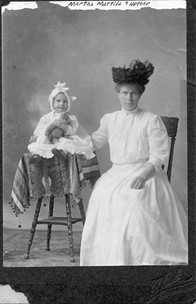
Norwegians On Tour
This week my husband/tech advisor and I had the opportunity to have dinner with a group of travelers from Norway. These 40 or so Norwegians came across the sea to tour the American Southwest. Upon their arrival, they stopped in Denver for a couple of days. The Trollheim Lodge of Sons of Norway hosted a supper for them and invited locals of Norwegian descent to participate. We greeted the tour bus with waving Norwegian flags.
Once inside the Lodge building, we all enjoyed a Western meal of pulled pork sandwiches, potato salad, cole slaw, and baked beans. Of course, the Trollheim folks added some Norwegian touches like pickles (beets and cucumbers), desserts, and coffee, lots and lots of coffee.
Few of the Americans speak much Norwegian, but many Norwegians speak fluent English. This allowed for international conversations all along the banquet tables. We learned about the tourists’ travel plans and something about their homeland.
I also had an opportunity to ask a few questions in anticipation of our own planned visit to Norway next spring. The Norwegian group did not come from any of the areas on our itinerary, but some of them had visited places like Bergen and Lake Mjösa. They pointed us to must-see sites.
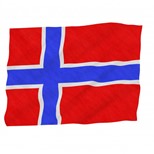
I enjoyed my pivot from research on my American brick-wall ancestors. Although my mom’s family has resided in the U.S. for over 100 years now, I still feel comfortable with Nordic culture. A week spent interacting with the Finns and the Norwegians was time well-spent.
52 Stories #2—Teaching Myself Hardanger Embroidery
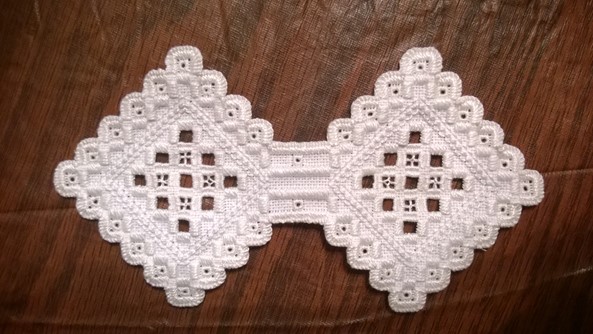 I have some Norwegian ancestry. Because of this, I have sought to learn a bit about Norwegian culture. One aspect of Norwegian life that I have found appealing is their love and pursuit of artistic crafts. Many years ago, I became interested in Norwegian Hardanger embroidery, a type of needlework unique to them. I resolved to teach myself to do it.
I have some Norwegian ancestry. Because of this, I have sought to learn a bit about Norwegian culture. One aspect of Norwegian life that I have found appealing is their love and pursuit of artistic crafts. Many years ago, I became interested in Norwegian Hardanger embroidery, a type of needlework unique to them. I resolved to teach myself to do it.
Hardanger is a specialized technique of cut and drawn stitchwork, historically done with white thread on white evenweave cloth. It has its roots in ancient Persia, and perhaps the Vikings took embroidered pieces home with them. Back in Norway, the local women adapted the stitches to the materials at hand—linen fabric and thread. The stitchery used today originated in the Hardanger area of Norway, hence its name. By the 1800’s, all young Norwegian girls learned to used Hardanger embroidery to decorate the linens in their hope chests as well as the cuffs of shirts they made for their eventual husbands.
My Norwegian great-grandmother, Sofie Sivertsdatter Bentsen, learned Hardanger when she grew up in Norway. I do not know whether she taught embroidery to her own daughters, one born in Norway and two born in the U. S., or whether any of them pursued Hardanger as a hobby. I do know that family members still have some of the pieces Sofie worked although I was not fortunate enough to receive any myself. I guess that comes from being descended from a son instead of a daughter.
My own mother, who was half Norwegian, knew how to embroider, but she never embroidered anything with Hardanger. I doubt she knew how. She and her Finnish mother both loved to embroider with the more familiar colorful stitches like cross stitch, and we had many pieces around the house that they had worked. They made dresser scarves, table clothes, pillow cases, framed pictures, etc.
When I was about 9 or 10 years old, my mother taught me the basic decorative embroidery stitches that she knew. Over the next twenty years or so, I happily stitched up many pieces that I used around my own house. Then one day I heard about Hardanger embroidery and its Norwegian roots. I was curious to learn more about it and to try it.
About that time, a woman from the Embroiderer’s Guild offered an afternoon session on Hardanger at the local community college. I took her class and received an introduction to the required materials and stitches. I loved it!
I purchased a couple of stitching guides, some Hardanger cloth, and some perle cotton at the local sewing store and embarked on a mission to teach myself how to embroider this way. I learned increasingly complicated stitches and made bookmarks, wall hangings, and doilies. At one point, I even spent about two years making a window valance that now hangs in my office.
When I joined the Sons of Norway a couple of years ago, I found that members can earn pins for learning Norwegian cultural skills. To earn the first level pin for Hardanger, one must research the history of the craft and then complete three pieces using the basis stitches. I did this and earned my Level I pin last year.
Teaching myself Hardanger embroidery has brought much joy and satisfaction into my life and has really given me a sense of accomplishment. I feel connected to my roots when I work on a piece. When I am finished, I have something to keep that I know I made myself. Mastering Hardanger embroidery has really enriched my life.
52 Ancestors in 52 Weeks nos. 53 & 54—Hans Pedersen and Maren Andersdatter
 Hans Enok Pedersen, my third great-grandfather, lived to be 84 years old. At the time of his death, he had a headful of thick hair with very little gray in it. Descendants, including my own mother, inherited this characteristic.
Hans Enok Pedersen, my third great-grandfather, lived to be 84 years old. At the time of his death, he had a headful of thick hair with very little gray in it. Descendants, including my own mother, inherited this characteristic.
Hans was born to Peder Andersen and Martha Johnsdatter on July 18, 1813 on the island of Øksnes, Vesterålen, Nordland in the Kingdom of Danmark-Norge. He was baptized at Øksnes parish the following autumn on the 28th of September.
When he was twenty-three years old Hans married Maren Anna Serina Andersdatter who was born at Malnes in the Bø Municipality of Vesterålen, Nordland. We do not know her birth date, but she was baptized on March 14, 1813 in Bø parish. The wedding of Hans and Maren took place at the Øksnes church, and Hans worked on the Fjeldgrimstad farm in Øksnes at the time.
Hans and Maren had at least two children:
- Martha Karoline Dorthea (my 2nd great grandmother), born March 20, 1841,
- Enok Andreas, born about 1850.
Eventually, the young family settled on the Dungan farm in Øksnes where Hans worked as a tenant farmer. In 1868, Maren served as godmother for her ill-fated granddaughter, Anna Marie Birgitte Sivertsdatter. Anna Marie was Martha’s third child, and she lived to be only a year old.
Maren passed away at about the age of 74, on July 5, 1886. She was buried in the Øksnes parish a couple of weeks later, on July 19, 1886.
Hans died several years later, on January 16, 1898. He was buried the following summer on July 11, 1898. His daughter Martha outlived him by only a couple of years.
52 Ancestors in 52 Weeks #51 & 52—Knud Sjursen and Brita Kristoffersdatter
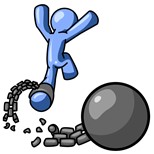 Knud and Brita, my third great-grandparents, were rebels.
Knud and Brita, my third great-grandparents, were rebels.
Both were born in the Hordaland District of Norway, but they fled their homes so they could marry. She was born into a higher-status family than he, and that was a barrier to their marriage. No matter. Together they went north to Nordland, and they did as they pleased.
Knud Sjursen was born on February 23, 1816 at Fenne Farm in the Voss Municipality of Hordaland. He was baptized two days later in the Vangen parish. His parents were Sjur Mathissen and Ingebor Knudsdatter. It seems he was named for his maternal grandfather.
Brita, the daughter of Christopher Monsen and Martha Olsdatter, was born just a few weeks before Knud, on January 9, 1816, at Oppeim, also in the Voss Municipality. She was baptized a month later, on February 2, 1816, at Voss.
Both Knud and Brita followed the same rites of passage as most other Norwegian youths of their time. They received their smallpox vaccinations and were confirmed in the Lutheran church.
By 1842, when they were 26 years old, they had both left their families and made their way to the distant island of Øksnes in the Vesterålen District of Nordland. Knud found work on the Sorsand farm, and Brita was on the Vottestad farm. They got married in Øksnes parish on July 11, 1842. Together they went on to have six children:
- Sivert Knudsen (1843-1907), my second great-grandfather,
- Kristoffer Knudsen (b. about 1844),
- Ingeborg Knudsdatter (b. about 1846),
- Elias Knudsen (b. about 1849),
- Karoline Knudsdatter (b. about 1853),
- Karl Knudsen (b. about 1860).
By 1865, the family had moved on to the Bjorndal farm in the Hadsel Municipality of Vesterålen. Knud worked as a tenant farmer. He and Brita stayed there for the rest of their lives and watched their family grow. On July 15, 1866, they served as godparents for their son Sivert’s first child, Kaspara Helmine Sivertsdatter at Øksnes.
After a lifetime together, Knud was the first to pass away. He died on February 24, 1885, the day after his 69th birthday. He was buried two months later, on April 12, 1885 in the Eidsfjord parish of Nordland.
Brita outlived him by just two years. She died on January 2, 1887, a week before what would have been her 71st birthday. She was buried the following spring, on May 30, also at Eidsfjord parish.
Knud and Brita had successfully defied their families to be together. Their marriage lasted 42 years.
52 Ancestors in 52 Weeks #49 & 50—Johan Larsen and Sara Möllersdatter
My third great-grandfather Johan Larsen was born March 22, 1824 on the island of Alstahaug in Nordland, Norway, just south of the Arctic Circle. His parents Lars Hemingsen and Jonelle Jonsdatter had him baptized in the Herøy i Alstahaug parish some time later.
When he was twenty-one years old, Johan married Sara Andrine Möllersdatter in the same parish on the nearby island of Slapøen on July 19, 1845. Sara was the daughter of Möller Zacariasen. Much older than Johan, Sara had been born about 1814 on the Berfjorden farm in the Alstahaug Municipality.
The couple set up housekeeping at Slapøen and began their family:
- Johana Maria, born at Slapøen on September 25, 1845,
- Bergitta Susanna, born at Slapøen on September 8, 1848,
- Karen Marie, born at Titternes farm in Dønnes on April 7, 1851 (my great-great grandmother),
- Ludvig Edvart, born at Næsna in Dønnes on May 17, 1855,
- Anne Margrete Kristine, born at Skeidsøen farm in Dønnes on March 12 1859,
- Mortine Lovise, born at Skeidsøen farm in Dønnes on June 19, 1863.
As he raised his family, Johan became a small landholder at Skeidsøen, and he worked sometimes as a fisherman. Perhaps during the fishing season that ran from January to May each year, he traveled with the other men from his area to the rich Lofoten fishing grounds north of Dønnes to earn some extra cash.
On March 6, 1876, shortly before his 52nd birthday, Johan died in a fishing accident. His death is recorded not in his home parish in Dønnes, but further north in Lofoten. He must have gone there to fish that season. Many of the deaths recorded on the same page of the Vågan parish register in Lofoten note a death at sea, so perhaps that is how Johan died, too. It seems the boats lost many men that fishing season.
Johan was buried later that month on March 25, 1876 in the Vågan parish of Lofoten.
Sara remained at Dønnes to live out the remainder of her life. She passed away on August 1, 1880 when she was about 66 years old. She was buried in the Herøy I Herøy parish.
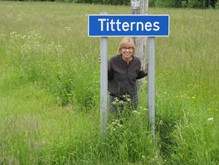
52 Ancestors in 52 Weeks #47 and 48—Anders Bentsen and Anne Larsdatter
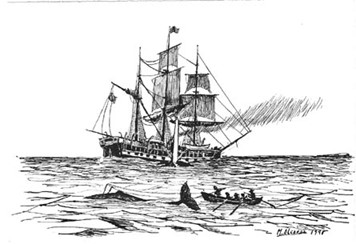 Anders Bentsen was the last Bentsen ancestor of mine who did not immigrate to America. He was also the man from whom my mother’s family took their surname when they did move to the United States from Norway. Because most Norwegians of his time did not have surnames, the family had to choose one when they immigrated. In Norway, they were known simply by their father’s name (a patronymic) plus the name of farm where they lived.
Anders Bentsen was the last Bentsen ancestor of mine who did not immigrate to America. He was also the man from whom my mother’s family took their surname when they did move to the United States from Norway. Because most Norwegians of his time did not have surnames, the family had to choose one when they immigrated. In Norway, they were known simply by their father’s name (a patronymic) plus the name of farm where they lived.
Anders was the son of Bent Iversen. Thus, his patronymic name was Bentsen, or Bent’s son. When Anders’ son Lorenz Nikolai and his grandson Ole Jørgen crossed the pond, they both decided to call themselves Bentsen, as their patriarch had, instead of using their own patronymic names, Andersen and Lorenzen.
Anders was born October 16, 1823, perhaps at the Norwegian coastal city of Bergen. By 1844 he had relocated north to the cod fishing area of Nordland, Norway, north of the Arctic Circle. He lived in Bø parish on one of the islands in the Vesterålen District and worked as a cottager. He fished, too, and sometimes worked on a whaling ship. One time they harpooned a huge whale off the north coast of Norway. It started pulling them toward Russia so they cut the line and let it go.
Anders’ daughter Christina Andrea was born at Bø on August 28, 1851. Anders finally married her mother, Anne Larsdatter, a couple of months later on October 24, 1851. They later had a son, Lorenz Nikolai, born on July 5, 1854 on Fjærvold farm.
In 1857, life for Anders and Anne took a terrible turn. On April 17 of that year, Anders reported the February 25 birth of an unnamed stillborn son. The following fall, Anders came down with a terrible fever.
He never recovered. Anders passed away from the fever on September 11, 1857 at the age of thirty-three. He was later buried in Bø parish on October 18. He left behind a widow, a six-year-old daughter, and a three-year-old son. That son grew up and emigrated to America.
Although Anders died young, Bentsen descendants live across the United States today.